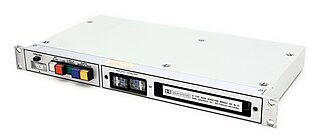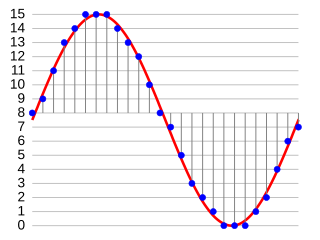Windows Media Audio (WMA) is a series of audio codecs and their corresponding audio coding formats developed by Microsoft. It is a proprietary technology that forms part of the Windows Media framework. WMA consists of four distinct codecs. The original WMA codec, known simply as WMA, was conceived as a competitor to the popular MP3 and RealAudio codecs. WMA Pro, a newer and more advanced codec, supports multichannel and high resolution audio. A lossless codec, WMA Lossless, compresses audio data without loss of audio fidelity. WMA Voice, targeted at voice content, applies compression using a range of low bit rates. Microsoft has also developed a digital container format called Advanced Systems Format to store audio encoded by WMA.
Voice over Internet Protocol (VoIP), also called IP telephony, is a method and group of technologies for the delivery of voice communications and multimedia sessions over Internet Protocol (IP) networks, such as the Internet. The terms Internet telephony, broadband telephony, and broadband phone service specifically refer to the provisioning of communications services over the Internet, rather than via the public switched telephone network (PSTN), also known as plain old telephone service (POTS).
Dolby Digital, originally synonymous with Dolby AC-3, is the name for what has now become a family of audio compression technologies developed by Dolby Laboratories. Formerly named Dolby Stereo Digital until 1995, the audio compression is lossy, based on the modified discrete cosine transform (MDCT) algorithm. The first use of Dolby Digital was to provide digital sound in cinemas from 35 mm film prints; today, it is now also used for applications such as TV broadcast, radio broadcast via satellite, digital video streaming, DVDs, Blu-ray discs and game consoles.

A Dolby noise-reduction system, or Dolby NR, is one of a series of noise reduction systems developed by Dolby Laboratories for use in analog audio tape recording. The first was Dolby A, a professional broadband noise reduction system for recording studios in 1965, but the best-known is Dolby B, a sliding band system for the consumer market, which helped make high fidelity practical on cassette tapes, which used a relatively noisy tape size and speed. It is common on high fidelity stereo tape players and recorders to the present day. Of the noise reduction systems, Dolby A and Dolby SR were developed for professional use. Dolby B, C, and S were designed for the consumer market. Aside from Dolby HX, all the Dolby variants work by companding: compressing the dynamic range of the sound during recording, and expanding it during playback.
A cassette deck is a type of tape machine for playing and recording audio cassettes that does not have a built-in power amplifier or speakers, and serves primarily as a transport. It can be a part of an automotive entertainment system, a part of a portable mini system or a part of a home component system. In the latter case it is also called a component cassette deck or just a component deck.

Adobe Audition is a digital audio workstation developed by Adobe Inc. featuring both a multitrack, non-destructive mix/edit environment and a destructive-approach waveform editing view.

Dolby Laboratories, Inc. is an American company specializing in audio noise reduction, audio encoding/compression, spatial audio, and HDR imaging. Dolby licenses its technologies to consumer electronics manufacturers.

G.722 is an ITU-T standard 7 kHz wideband audio codec operating at 48, 56 and 64 kbit/s. It was approved by ITU-T in November 1988. Technology of the codec is based on sub-band ADPCM (SB-ADPCM). The corresponding narrow-band codec based on the same technology is G.726.

High-Efficiency Advanced Audio Coding (HE-AAC) is an audio coding format for lossy data compression of digital audio defined as an MPEG-4 Audio profile in ISO/IEC 14496–3. It is an extension of Low Complexity AAC (AAC-LC) optimized for low-bitrate applications such as streaming audio. The usage profile HE-AAC v1 uses spectral band replication (SBR) to enhance the modified discrete cosine transform (MDCT) compression efficiency in the frequency domain. The usage profile HE-AAC v2 couples SBR with Parametric Stereo (PS) to further enhance the compression efficiency of stereo signals.
Conexant Systems, Inc. was an American-based software developer and fabless semiconductor company that developed technology for voice and audio processing, imaging and modems. The company began as a division of Rockwell International, before being spun off as a public company. Conexant itself then spun off several business units, creating independent public companies which included Skyworks Solutions and Mindspeed Technologies.

DTS, Inc. is an American company that makes multichannel audio technologies for film and video. Based in Calabasas, California, the company introduced its DTS technology in 1993 as a competitor to Dolby Laboratories, incorporating DTS in the film Jurassic Park (1993). The DTS product is used in surround sound formats for both commercial/theatrical and consumer-grade applications. It was known as The Digital Experience until 1995. DTS licenses its technologies to consumer electronics manufacturers.
Dolby Stereo is a sound format made by Dolby Laboratories. It is a unified brand for two completely different basic systems: the Dolby SVA 1976 system used with optical sound tracks on 35mm film, and Dolby Stereo 70mm noise reduction on 6-channel magnetic soundtracks on 70mm prints.
Wideband audio, also known as wideband voice or HD voice, is high definition voice quality for telephony audio, contrasted with standard digital telephony "toll quality". It extends the frequency range of audio signals transmitted over telephone lines, resulting in higher quality speech. The range of the human voice extends from 100 Hz to 17 kHz but traditional, voiceband or narrowband telephone calls limit audio frequencies to the range of 300 Hz to 3.4 kHz. Wideband audio relaxes the bandwidth limitation and transmits in the audio frequency range of 50 Hz to 7 kHz. In addition, some wideband codecs may use a higher audio bit depth of 16 bits to encode samples, also resulting in much better voice quality.

In sound recording and reproduction, audio mixing is the process of optimizing and combining multitrack recordings into a final mono, stereo or surround sound product. In the process of combining the separate tracks, their relative levels are adjusted and balanced and various processes such as equalization and compression are commonly applied to individual tracks, groups of tracks, and the overall mix. In stereo and surround sound mixing, the placement of the tracks within the stereo field are adjusted and balanced. Audio mixing techniques and approaches vary widely and have a significant influence on the final product.
Audience was an American mobile voice and audio-processing company based in Mountain View, California, and was one of the 34 founding members of The Open Handset Alliance. The company went public in May 2012 on the NASDAQ exchange under the symbol ADNC. They specialized in improving voice clarity and noise suppression for a broad range of consumer products, including cellular phones, mobile devices and PCs. They were bought by Knowles for $130 Million in 3Q15 who changed their name to Knowles Intelligent Audio.

aptX is a family of proprietary audio codec compression algorithms owned by Qualcomm, with a heavy emphasis on wireless audio applications.
Pulse-code modulation (PCM) is a method used to digitally represent sampled analog signals. It is the standard form of digital audio in computers, compact discs, digital telephony and other digital audio applications. In a PCM stream, the amplitude of the analog signal is sampled regularly at uniform intervals, and each sample is quantized to the nearest value within a range of digital steps.

Opus is a lossy audio coding format developed by the Xiph.Org Foundation and standardized by the Internet Engineering Task Force, designed to efficiently code speech and general audio in a single format, while remaining low-latency enough for real-time interactive communication and low-complexity enough for low-end embedded processors. Opus replaces both Vorbis and Speex for new applications, and several blind listening tests have ranked it higher-quality than any other standard audio format at any given bitrate until transparency is reached, including MP3, AAC, and HE-AAC.
Enhanced Voice Services (EVS) is a superwideband speech audio coding standard that was developed for VoLTE. It offers up to 20 kHz audio bandwidth and has high robustness to delay jitter and packet losses due to its channel aware coding and improved packet loss concealment. It has been developed in 3GPP and is described in 3GPP TS 26.441. The application areas of EVS consist of improved telephony and teleconferencing, audiovisual conferencing services, and streaming audio. Source code of both decoder and encoder in ANSI C is available as 3GPP TS 26.442 and is being updated regularly. Samsung uses the term HD+ when doing a call using EVS.

Google Meet is a proprietary voice over IP (VoIP) and videotelephony service developed by Google, available for Android, iOS and web browsers. It is one of two apps that constitute the replacement for Google Hangouts and Google Duo, the other being Google Chat. It lets users make and receive one-to-one and group audio and video calls with other Meet users in high definition, using end-to-end encryption by default. Meet can be used either with a phone number or a Google account, allowing users to call someone from their contact list.









